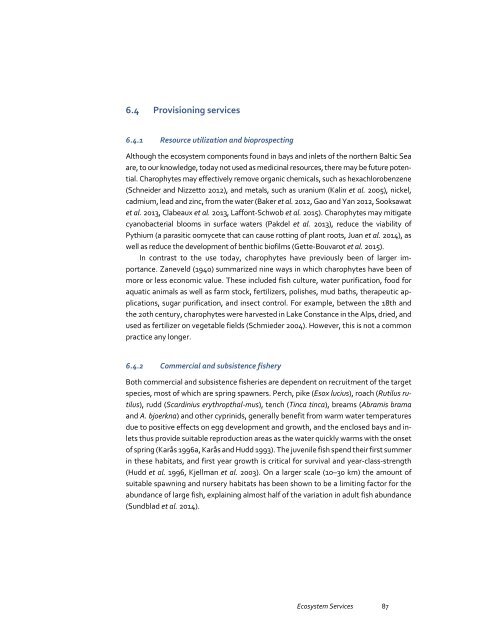Ecosystem Services
FULLTEXT01
FULLTEXT01
You also want an ePaper? Increase the reach of your titles
YUMPU automatically turns print PDFs into web optimized ePapers that Google loves.
6.4 Provisioning services<br />
6.4.1 Resource utilization and bioprospecting<br />
Although the ecosystem components found in bays and inlets of the northern Baltic Sea<br />
are, to our knowledge, today not used as medicinal resources, there may be future potential.<br />
Charophytes may effectively remove organic chemicals, such as hexachlorobenzene<br />
(Schneider and Nizzetto 2012), and metals, such as uranium (Kalin et al. 2005), nickel,<br />
cadmium, lead and zinc, from the water (Baker et al. 2012, Gao and Yan 2012, Sooksawat<br />
et al. 2013, Clabeaux et al. 2013, Laffont-Schwob et al. 2015). Charophytes may mitigate<br />
cyanobacterial blooms in surface waters (Pakdel et al. 2013), reduce the viability of<br />
Pythium (a parasitic oomycete that can cause rotting of plant roots, Juan et al. 2014), as<br />
well as reduce the development of benthic biofilms (Gette-Bouvarot et al. 2015).<br />
In contrast to the use today, charophytes have previously been of larger importance.<br />
Zaneveld (1940) summarized nine ways in which charophytes have been of<br />
more or less economic value. These included fish culture, water purification, food for<br />
aquatic animals as well as farm stock, fertilizers, polishes, mud baths, therapeutic applications,<br />
sugar purification, and insect control. For example, between the 18th and<br />
the 20th century, charophytes were harvested in Lake Constance in the Alps, dried, and<br />
used as fertilizer on vegetable fields (Schmieder 2004). However, this is not a common<br />
practice any longer.<br />
6.4.2 Commercial and subsistence fishery<br />
Both commercial and subsistence fisheries are dependent on recruitment of the target<br />
species, most of which are spring spawners. Perch, pike (Esox lucius), roach (Rutilus rutilus),<br />
rudd (Scardinius erythropthal-mus), tench (Tinca tinca), breams (Abramis brama<br />
and A. bjoerkna) and other cyprinids, generally benefit from warm water temperatures<br />
due to positive effects on egg development and growth, and the enclosed bays and inlets<br />
thus provide suitable reproduction areas as the water quickly warms with the onset<br />
of spring (Karås 1996a, Karås and Hudd 1993). The juvenile fish spend their first summer<br />
in these habitats, and first year growth is critical for survival and year-class-strength<br />
(Hudd et al. 1996, Kjellman et al. 2003). On a larger scale (10–30 km) the amount of<br />
suitable spawning and nursery habitats has been shown to be a limiting factor for the<br />
abundance of large fish, explaining almost half of the variation in adult fish abundance<br />
(Sundblad et al. 2014).<br />
<strong>Ecosystem</strong> <strong>Services</strong> 87


